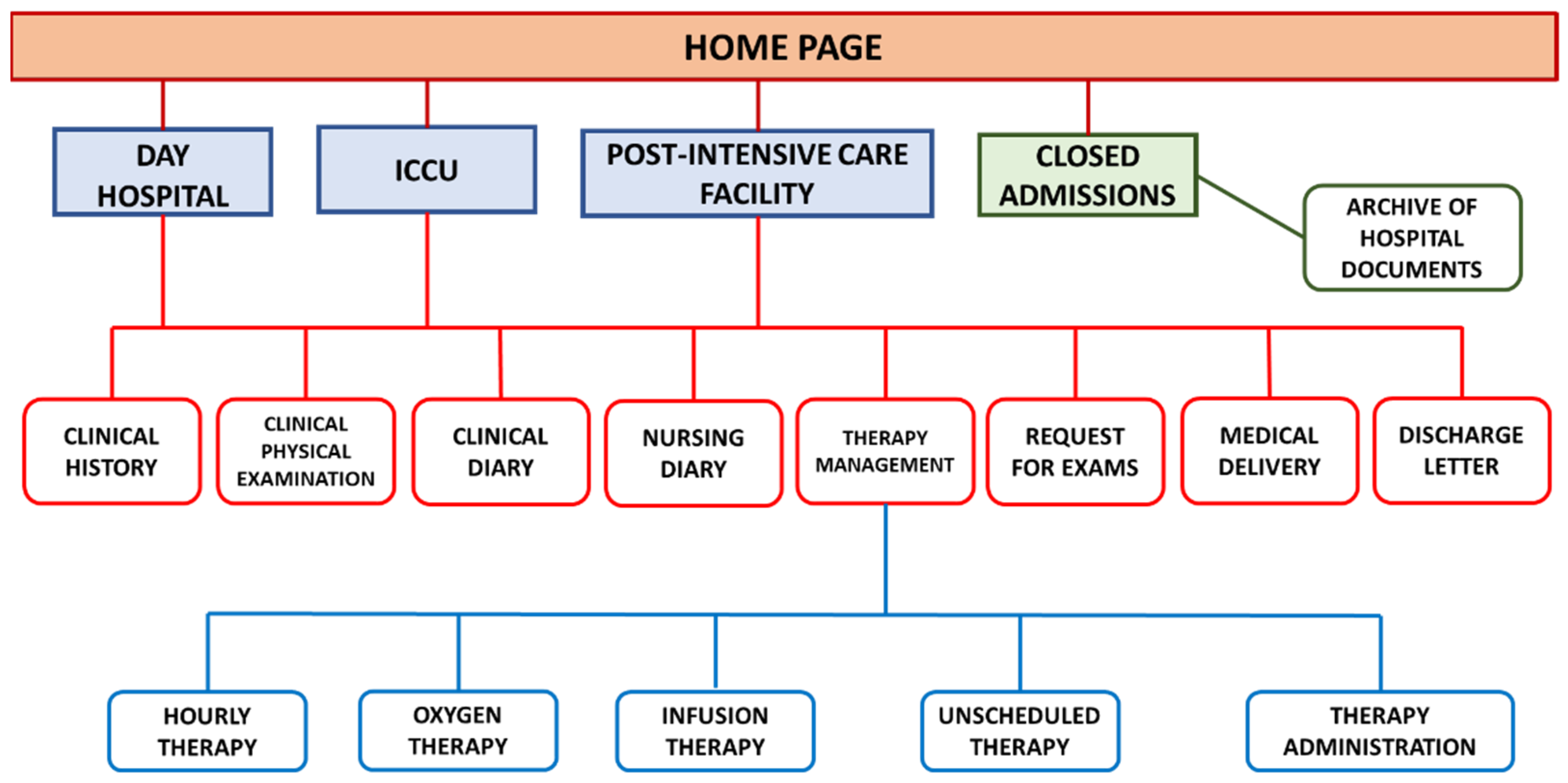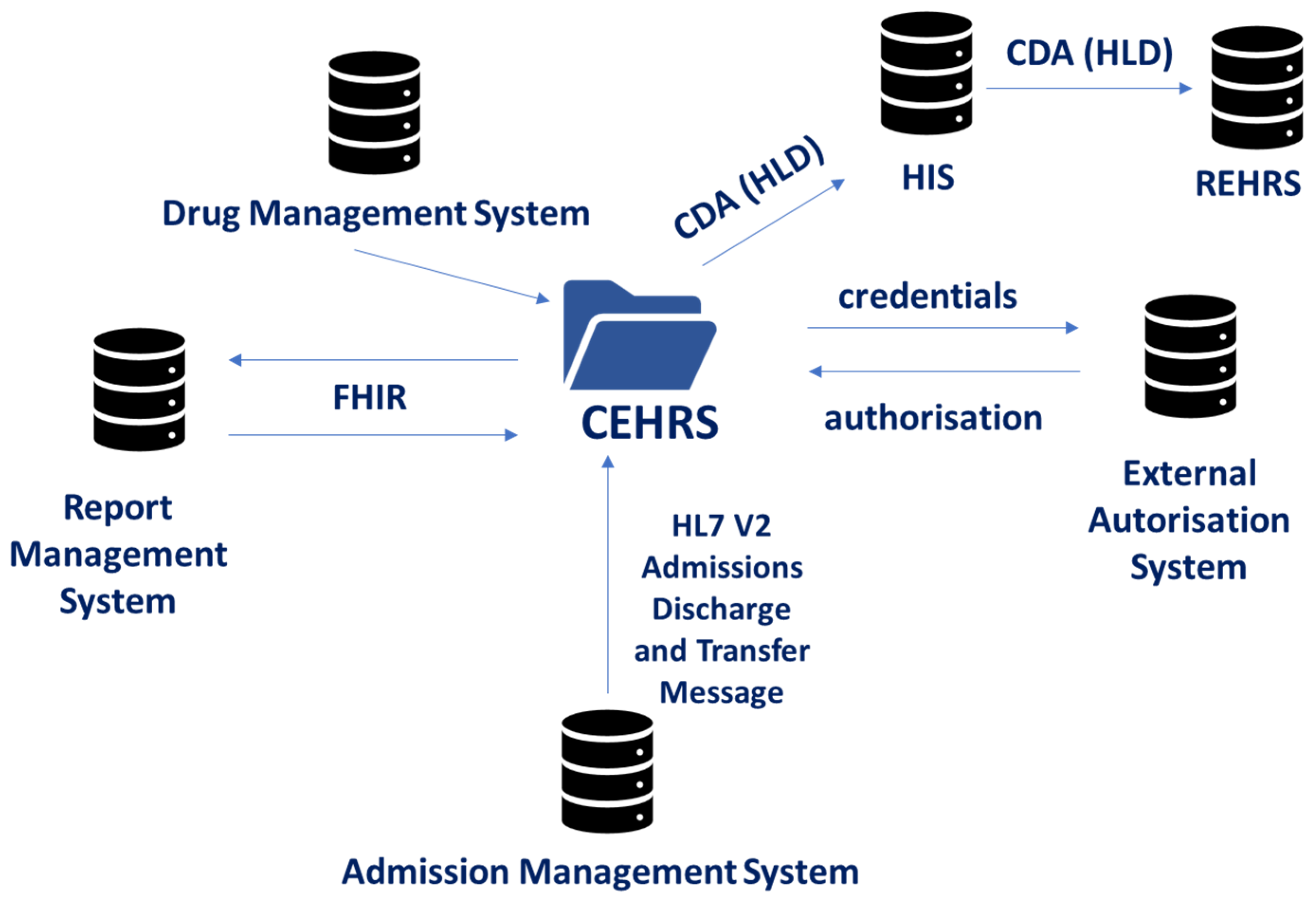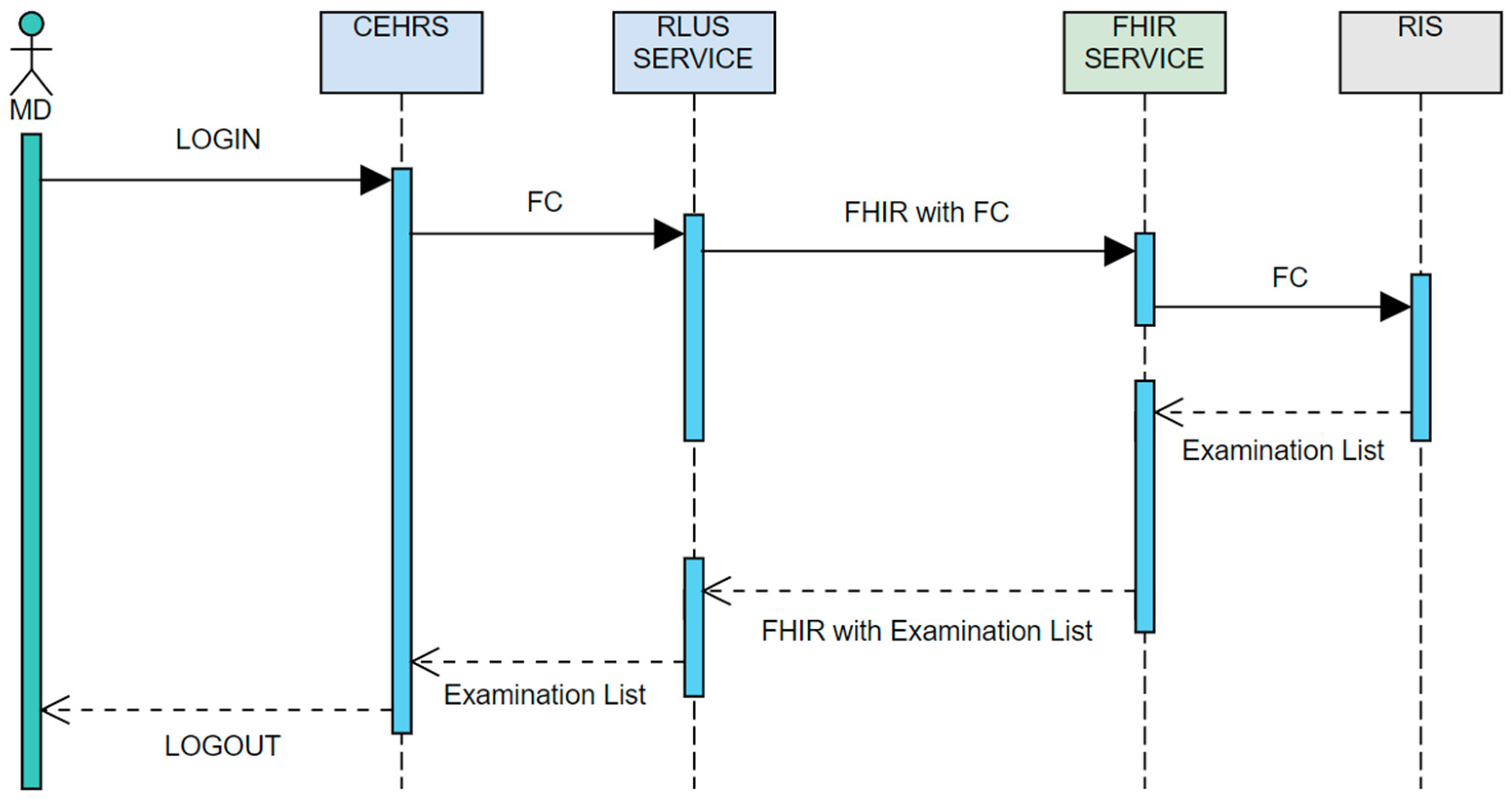An Interoperable Electronic Health Record System for Clinical Cardiology
Abstract
:1. Introduction
- Therapy: the hospital’s expressed requirements were related to ensuring the identity of the prescribing doctor, the prescribed drug, the administering nurse and to confirm the occurred administration with a high certainty level;
- Referrals: the expressed requirements of the hospital were related to the availability on the same platform of results of examinations and diagnostics carried out on other platforms;
- Discharge letter: the hospital required that the main data stored during hospitalization were easily transferable to the discharge letter, which must be produced according to the standards indicated by the Italian Government.
2. Materials and Methods
3. Results
3.1. Description of the CEHRS Modules
3.2. Interoperability TOOLS
3.2.1. Authentication and Authorization Procedure
3.2.2. Admission management system
3.2.3. Report Management System
- −
- The user chooses the patient whose reports he/she wants to visualize. This is the “trigger event”, which is used by the HL7 environment to start the process that retrieves the requested information.
- −
- The fiscal code (FC) of the patient is transmitted to the RLUS service by a FHIR message (FC is used in Italy as a unique identifier of Italian citizens; in this context, only communications protected by the HIS firewall are allowed to use FCs). The RIS provides the list of all available reports for each patient to the RLUS service by a FHIR message and the RLUS sends the list of exams to the CEHRS.
- −
- The user chooses the report he/she requires.
- −
- The metadata of the report are transferred to the RIS by the RLUS service, and subsequently by the CDA service, which finds the report and sends it to the CEHRS.
3.2.4. HDL Management System
3.3. Description of the Decision Support Tools
3.3.1. Therapy administration
3.3.2. HDL Drafting
3.4. Emergency System
3.5. Practical Implications of the System
4. Discussion
5. Conclusions
Author Contributions
Funding
Institutional Review Board Statement
Informed Consent Statement
Data Availability Statement
Acknowledgments
Conflicts of Interest
Appendix A
- Connection blocking for unauthorized devices and staff;
- Firewall antispam, antimalware, antivirus;
- Internet protocols of any resource connected to the network;
- Authorization and checking of all installed software;
- Dedicated VLAN fractioning;
- Minimal and identified TCP ports opening;
- Backup update procedures and network systems recovery;
- Disaster recovery policies to guarantee operational continuity of particularly sensitive systems;
- Tracking on the operations carried out on local health company software;
- Deactivation of all automatisms that may allow unauthorized access to systems.
References
- Tsiknakis, M. An open, component-based information infrastructure for integrated health information networks. Int. J. Med. Inform. 2002, 68, 3–26. [Google Scholar] [CrossRef]
- World Health Organization. Global Strategy on Digital Health 2020–2025; World Health Organization: Geneva, Switzerland, 2021. [Google Scholar]
- McMullen, P.C.; Howie, W.O.; Philipsen, N.; Bryant, V.C.; Setlow, P.D.; Calhoun, M.; Green, Z.D. Electronic Medical Records and Electronic Health Records: Overview for Nurse Practitioners. J. Nurse Pract. 2014, 10, 660–665. [Google Scholar] [CrossRef]
- Uslu, A.; Stausberg, J. Value of the Electronic Medical Record for Hospital Care: Update From the Literature. J. Med. Internet Res. 2021, 23, e26323. [Google Scholar] [CrossRef]
- Melton, G.B.; McDonald, C.J.; Tang, P.C.; Hripcsak, G. Electronic Health Records. In Biomedical Informatics, 5th ed.; Shortliffe, E.H., Cimino, J.J., Eds.; Springer: Cham, Switzerland, 2021; pp. 467–509. [Google Scholar] [CrossRef]
- Atasoy, H.; Greenwood, B.N.; McCullough, J.S. The Digitization of Patient Care: A Review of the Effects of Electronic Health Records on Health Care Quality and Utilization. Annu. Rev. Public Health 2019, 40, 487–500. [Google Scholar] [CrossRef] [PubMed] [Green Version]
- Jensen, P.B.; Jensen, L.J.; Brunak, S. Mining electronic health records: Towards better research applications and clinical care. Nat. Rev. Genet. 2012, 13, 395–405. [Google Scholar] [CrossRef] [PubMed]
- Weiskopf, N.G.; Hripcsak, G.; Swaminathan, S.; Weng, C. Defining and measuring completeness of electronic health records for secondary use. J. Biomed. Inform. 2013, 46, 830–836. [Google Scholar] [CrossRef] [Green Version]
- Davidson, J.; Banerjee, A.; Muzambi, R.; Smeeth, L.; Warren-Gash, C. Validity of Acute Cardiovascular Outcome Diagnoses Recorded in European Electronic Health Records: A Systematic Review. Clin. Epidemiol. 2020, 12, 1095–1111. [Google Scholar] [CrossRef]
- Martin, G.P.; Mamas, M.A. Importance of quality control in ‘big data’: Implications for statistical inference of electronic health records in clinical cardiology. Cardiovasc. Res. 2019, 115, e63–e65. [Google Scholar] [CrossRef]
- Nadarajah, R.; Wu, J.; Frangi, A.F.; Hogg, D.; Cowan, C.; Gale, C. Predicting patient-level new-onset atrial fibrillation from population-based nationwide electronic health records: Protocol of FIND-AF for developing a precision medicine prediction model using artificial intelligence. BMJ Open 2021, 11, e052887. [Google Scholar] [CrossRef]
- Choi, E.; Schuetz, A.; Stewart, W.F.; Sun, J. Using recurrent neural network models for early detection of heart failure onset. J. Am. Med. Inform. Assoc. 2017, 24, 361–370. [Google Scholar] [CrossRef] [Green Version]
- Wang, R.; Weng, Y.; Zhou, Z.; Chen, L.; Hao, H.; Wang, J. Multi-objective ensemble deep learning using electronic health records to predict outcomes after lung cancer radiotherapy. Phys. Med. Biol. 2019, 64, 245005. [Google Scholar] [CrossRef]
- Payne, T.H.; Zhao, L.P.; Le, C.; Wilcox, P.; Yi, T.; Hinshaw, J.; Hussey, D.; Kostrinsky-Thomas, A.; Hale, M.; Brimm, J.; et al. Electronic health records contain dispersed risk factor information that could be used to prevent breast and ovarian cancer. J. Am. Med. Inform. Assoc. 2020, 27, 1443–1449. [Google Scholar] [CrossRef]
- Wu, Y.; Warner, J.L.; Wang, L.; Jiang, M.; Xu, J.; Chen, Q.; Nian, H.; Dai, Q.; Du, X.; Yang, P.; et al. Discovery of Noncancer Drug Effects on Survival in Electronic Health Records of Patients With Cancer: A New Paradigm for Drug Repurposing. JCO Clin. Cancer Inform. 2019, 3, 1–9. [Google Scholar] [CrossRef]
- Zong, N.; Wen, A.; Stone, D.J.; Sharma, D.K.; Wang, C.; Yu, Y.; Liu, H.; Shi, Q.; Jiang, G. Developing an FHIR-Based Computational Pipeline for Automatic Population of Case Report Forms for Colorectal Cancer Clinical Trials Using Electronic Health Records. JCO Clin. Cancer Inform. 2020, 4, 201–209. [Google Scholar] [CrossRef]
- Lin, W.-C.; Chen, J.S.; Chiang, M.F.; Hribar, M.R. Applications of Artificial Intelligence to Electronic Health Record Data in Ophthalmology. Transl. Vis. Sci. Technol. 2020, 9, 13. [Google Scholar] [CrossRef] [Green Version]
- Bonetto, M.; Nicolo, M.; Gazzarata, R.; Fraccaro, P.; Rosa, R.; Musetti, D.; Musolino, M.; Traverso, C.E.; Giacomini, M. I-Maculaweb: A Tool to Support Data Reuse in Ophthalmology. IEEE J. Transl. Eng. Health Med. 2016, 4, 1–10. [Google Scholar] [CrossRef]
- Nicolò, M.; Morlacchi, A.; Cappelli, F.; Ferro Desideri, L.; Colombo, V.; Musetti, D.; Musolino, M.; Saccheggiani, M.; Bonetto, M.; Giacomini, M.; et al. Real-Life Data in the Treatment of Neovascular Age-Related Macular Degeneration: Results from the Imaculaweb Registry Evaluated in a Single Italian Medical Retina Center. Ophthalmologica 2020, 243, 453–460. [Google Scholar] [CrossRef]
- Norgeot, B.; Glicksberg, B.S.; Trupin, L.; Lituiev, D.; Gianfrancesco, M.; Oskotsky, B.; Schmajuk, G.; Yazdany, J.; Butte, A.J. Assessment of a Deep Learning Model Based on Electronic Health Record Data to Forecast Clinical Outcomes in Patients with Rheumatoid Arthritis. JAMA Netw. Open 2019, 2, e190606. [Google Scholar] [CrossRef] [Green Version]
- Maarseveen, T.D.; Meinderink, T.; Reinders, M.J.T.; Knitza, J.; Huizinga, T.W.J.; Kleyer, A.; Simon, D.; van den Akker, E.B.; Knevel, R. Machine Learning Electronic Health Record Identification of Patients with Rheumatoid Arthritis: Algorithm Pipeline Development and Validation Study. JMIR Med. Inform. 2020, 8, e23930. [Google Scholar] [CrossRef]
- Rahman, R.; Reddy, C.K. Electronic Health Records: A Survey. In Healthcare Data Analytics; Reddy, C.K., Aggarwal, C.C., Eds.; Chapman and Hall/CRC: New York, NY, USA, 2015. [Google Scholar]
- Dolin, R.H.; Alschuler, L.; Boyer, S.; Beebe, C.; Behlen, F.M.; Biron, P.V.; Shabo Shvo, A. HL7 Clinical Document Architecture, Release 2. J. Am. Med. Inform. Assoc. 2006, 13, 30–39. [Google Scholar] [CrossRef] [Green Version]
- Saripalle, R.; Runyan, C.; Russell, M. Using HL7 FHIR to achieve interoperability in patient health record. J. Biomed. Inform. 2019, 94, 103188. [Google Scholar] [CrossRef]
- Joyia, G.J.; Akram, M.U.; Akbar, C.N.; Maqsood, M.F. Evolution of Health Level-7. In Proceedings of the 2018 International Conference on Software Engineering and Information Management-ICSIM2018, Casablanca, Morocco, 4–6 January 2018; pp. 118–123. [Google Scholar]
- Lehne, M.; Luijten, S.; Vom Felde Genannt Imbusch, P.; Thun, S. The Use of FHIR in Digital Health-A Review of the Scientific Literature. Stud. Health Technol. Inform. 2019, 267, 52–58. [Google Scholar] [CrossRef]
- Decreto del presidente del consiglio dei ministri 29 settembre 2015, n. 178. In Regolamento in Materia di Fascicolo Sanitario Elettronico; Gazzetta Ufficiale Serie Generale n.263 del 11-11-2015, 178/2015; 2015; Available online: http://www.normattiva.it/eli/id/2015/11/11/15G00192/ORIGINAL (accessed on 6 May 2022).
- Gazzarata, R.; Giannini, B.; Giacomini, M. A SOA-Based Platform to Support Clinical Data Sharing. J. Healthc. Eng. 2017, 2017, 2190679. [Google Scholar] [CrossRef]
- HL7 Version 3 Standard: Retrieve, Locate, and Update Service (RLUS) Release 1. Available online: https://www.hl7.org/implement/standards/product_brief.cfm?product_id=89 (accessed on 30 May 2022).
- Sordo, M.; Boxwala, A.A.; Ogunyemi, O.; Greenes, R.A. Description and status update on GELLO: A proposed standardized object-oriented expression language for clinical decision support. Stud. Health Technol. Inform. 2004, 107, 164–168. [Google Scholar]
- Bellini, R.; Ceola, M.; Russo, A.; Guerrazzi, F.; Gottin, L. Ventumask for lung atelectasis after cardiac surgery: A pilot study. In Proceedings of the SIMFER Conference, Ancona, Italy, 23–30 September 2018; pp. 8–10. [Google Scholar]
- Evans, R.S. Electronic Health Records: Then, Now, and in the Future. Yearb. Med. Inform. 2018, 25, S48–S61. [Google Scholar] [CrossRef]
- Shull, J.G. Digital Health and the State of Interoperable Electronic Health Records. JMIR Med. Inform. 2019, 7, e12712. [Google Scholar] [CrossRef]
- Sittig, D.F.; Belmont, E.; Singh, H. Improving the safety of health information technology requires shared responsibility: It is time we all step up. Healthcare 2018, 6, 7–12. [Google Scholar] [CrossRef]
- Poleto, T.; Carvalho, V.D.H.d.; Silva, A.L.B.d.; Clemente, T.R.N.; Silva, M.M.; Gusmão, A.P.H.d.; Costa, A.P.C.S.; Nepomuceno, T.C.C. Fuzzy Cognitive Scenario Mapping for Causes of Cybersecurity in Telehealth Services. Healthcare 2021, 9, 1504. [Google Scholar] [CrossRef]
- Lima, V.C.; Pellison, F.C.; Bernardi, F.A.; Alves, D.; Rijo, R.P.C.L. Security Framework for Tuberculosis Health Data Interoperability Through the Semantic Web. Int. J. Web Portals 2021, 13, 36–57. [Google Scholar] [CrossRef]
- Spanakis, E.G.; Sfakianakis, S.; Bonomi, S.; Ciccotelli, C.; Magalini, S.; Sakkalis, V. Emerging and Established Trends to Support Secure Health Information Exchange. Front. Digit. Health 2021, 3, 29. [Google Scholar] [CrossRef]
- Butt, G.Q.; Sayed, T.A.; Riaz, R.; Rizvi, S.S.; Paul, A. Secure Healthcare Record Sharing Mechanism with Blockchain. Appl. Sci. 2022, 12, 2307. [Google Scholar] [CrossRef]
- Negro-Calduch, E.; Azzopardi-Muscat, N.; Krishnamurthy, R.S.; Novillo-Ortiz, D. Technological progress in electronic health record system optimization: Systematic review of systematic literature reviews. Int. J. Med. Inform. 2021, 152, 104507. [Google Scholar] [CrossRef]
- Alami, H.; Gagnon, M.-P.; Ag Ahmed, M.A.; Fortin, J.-P. Digital health: Cybersecurity is a value creation lever, not only a source of expenditure. Health Policy Technol. 2019, 8, 319–321. [Google Scholar] [CrossRef]
- Yadav, R.; Murria, S.; Sharma, A. A research review on semantic interoperability issues in electronic health record systems in medical healthcare. In Intelligent Data-Centric Systems, IoT-Based Data Analytics for the Healthcare Industry; Singh, S.K., Singh, R.S., Pandey, A.K., Udmale, S.S., Chaudhary, A., Eds.; Academic Press: London, UK, 2021; pp. 123–138. [Google Scholar]
- de Mello, B.H.; Rigo, S.J.; da Costa, C.A.; da Rosa Righi, R.; Donida, B.; Bez, M.R.; Schunke, L.C. Semantic interoperability in health records standards: A systematic literature review. Health Technol. 2022, 12, 255–272. [Google Scholar] [CrossRef]
- Gansel, X.; Mary, M.; van Belkum, A. Semantic data interoperability, digital medicine, and e-health in infectious disease management: A review. Eur. J. Clin. Microbiol. Infect. Dis. 2019, 38, 1023–1034. [Google Scholar] [CrossRef]
- Gazzarata, R.; Maggi, N.; Magnoni, L.D.; Monteverde, M.E.; Ruggiero, C.; Giacomini, M. Semantics management for a regional health information system in Italy by CTS2 and FHIR. In Applying the FAIR Principles to Accelerate Health Research in Europe in the Post COVID-19 Era; Studies in Health Technology and Informatics; IOS Press: Amsterdam, The Netherlands, 2021. [Google Scholar]
- Mora, S.; Attene, J.; Gazzarata, R.; Parruti, G.; Giacomini, M. A NLP pipeline for the automatic extraction of microorganisms names from microbiological notes. In pHealth 2021; Studies in Health Technology and Informatics; IOS Press: Amsterdam, The Netherlands, 2021. [Google Scholar]
- Adel, E.; El-Sappagh, S.; Barakat, S.; Elmogy, M. Ontology-based electronic health record semantic interoperability: A survey. In U-Healthcare Monitoring Systems; Academic Press: Cambridge, MA, USA, 2019; pp. 315–352. [Google Scholar]











Publisher’s Note: MDPI stays neutral with regard to jurisdictional claims in published maps and institutional affiliations. |
© 2022 by the authors. Licensee MDPI, Basel, Switzerland. This article is an open access article distributed under the terms and conditions of the Creative Commons Attribution (CC BY) license (https://creativecommons.org/licenses/by/4.0/).
Share and Cite
Lazarova, E.; Mora, S.; Maggi, N.; Ruggiero, C.; Vitale, A.C.; Rubartelli, P.; Giacomini, M. An Interoperable Electronic Health Record System for Clinical Cardiology. Informatics 2022, 9, 47. https://doi.org/10.3390/informatics9020047
Lazarova E, Mora S, Maggi N, Ruggiero C, Vitale AC, Rubartelli P, Giacomini M. An Interoperable Electronic Health Record System for Clinical Cardiology. Informatics. 2022; 9(2):47. https://doi.org/10.3390/informatics9020047
Chicago/Turabian StyleLazarova, Elena, Sara Mora, Norbert Maggi, Carmelina Ruggiero, Alessandro Cosolito Vitale, Paolo Rubartelli, and Mauro Giacomini. 2022. "An Interoperable Electronic Health Record System for Clinical Cardiology" Informatics 9, no. 2: 47. https://doi.org/10.3390/informatics9020047
APA StyleLazarova, E., Mora, S., Maggi, N., Ruggiero, C., Vitale, A. C., Rubartelli, P., & Giacomini, M. (2022). An Interoperable Electronic Health Record System for Clinical Cardiology. Informatics, 9(2), 47. https://doi.org/10.3390/informatics9020047







